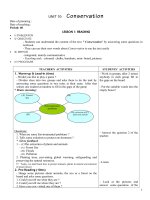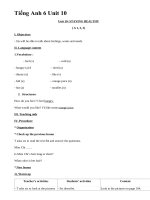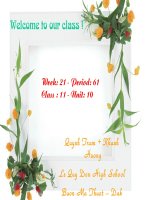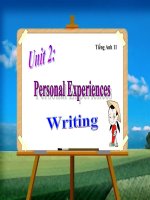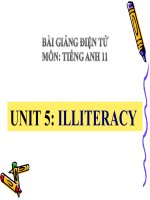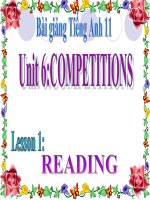Tieng anh 11 Unit 10- Reading
Bạn đang xem bản rút gọn của tài liệu. Xem và tải ngay bản đầy đủ của tài liệu tại đây (1.92 MB, 25 trang )
WELCOME TO OUR
CLASS !
Welcome to our class !
Week: 21 - Period: 61
Class : 11 - Unit: 10
Quynh Tram + Khanh
Huong
Le Quy Don High School
Buon Ma Thuot – Dak
Lak
UNIT 10
UNIT 10
•
SECTION A - READING
NATURE IN DANGER
•
Matching
Match the suitable words or
phrases on the left with the
pictures on the right.
WARM- UP
WARM- UP
a.
a.
3. Forest fire
3. Forest fire
4. Endangered
4. Endangered
species
species
2. Flood
2. Flood
1. Earthquake
1. Earthquake
b.
b.
c.
c.
d.
d.
Read the facts about
Read the facts about
endangered species and
endangered species and
discuss the questions
discuss the questions
below
below
•
Once found
throughout Africa,
cheetahs are now only
scattered throughout
east Africa.
•
It is estimated that only
1,000 pandas remain in
the wild.
•
There are only about 20
Siberian tigers left in
the wild in China and
about 100 live in
Chinese zoos and
national parks.
Question 1:
Question 1:
What do you understand
What do you understand
from the facts above?
from the facts above?
Question 2:
Can you explain why the
numbers of these animals
have become small?
1. The facts above show that the
numbers of some wild/ rare animals
such as cheetahs, pandas and Siberian
tigers become small/extinct.
2. The number of these animals
have become small because they
are killed for food, fur or skin.
Answer:
LISTEN TO THE TAPE
LISTEN TO THE TAPE
VOCABULARY
VOCABULARY
•
human race (n)
= people (n)
= human being (n)
•
agriculture (n) = farming (n)
•
pollutant (n)
(smoke or waste products
from factories)
VOCABULARY
VOCABULARY
•
respect (n) : khía cạnh
•
consequence (n) = result (n)
= effect (n)
# common (adj)
•
rare (adj)
•
extinct (adj)
Ex.: Dinosaur is an extinct species
: no longer in existence
VOCABULARY
VOCABULARY
•
prohibit (v) = forbid (v)
: can thiệp (đt)
•
interfere (v)
•
interference (n) : sự can thiệp (dt)
•
offspring (n) : the young of an animal
•
co-exist (v)
: to exist together
in the same place
Some notes: the use of some
phrasal verbs
- to have a great influence on (exp.)
- result in (v.)
- as the result (exp.)
- so ……… that ………
- in danger of becoming extinct (exp.)
pollutants
TASK 1: Fill each blank with a
TASK 1: Fill each blank with a
suitable word
suitable word
decreasing
protect
interference
extinct
endangered
1. Dinosaur became …….……… millions of years
ago.
2. She tried to ….………….herself from the wind.
4. The chemical …….… … from cars and factories
make the air; water and soil dangerously dirty.
3. This species of bird is ………… ….in numbers
every year.
5. The blue whale is a (n) ………………….species.
6. Because of the ………………… of human beings, many animals have become
extinct.
1. Paragraph 1
TASK 2: Circle A,B,C or D that best sums up
TASK 2: Circle A,B,C or D that best sums up
each paragraph.
each paragraph.
A.Human beings need to grow food.
B.Human beings pollute the environment.
C.Human beings interfere with nature.
D.People should stop living in cities and villages.
2. Paragraph 2
A.Many animals are disappearing.
B.Human beings are responsible for pollute
the environment.
C.People are in danger of becoming extinct.
D.The human race is also an endangered species.
C.Human beings interfere with nature.
B.Human beings are responsible for pollute
the environment.
3. Paragraph 3
A.Human beings have made efforts to protect
the environment.
B.Scientists have made a long list of endangered
species.
D.Rare animals do not disappear.
4. Paragraph 4
A. The survival of endangered species.
C. Conditions for a peaceful co-existence
D.People’s interference with the environment
C.People should be kept away from animals and
plants.
B.The Earth – a happy planet.
A.Human beings have made efforts to protect
the environment.
C. Conditions for a peaceful co-existence
1. What are the four ways by which human
beings are changing the world?
2. What are the serious consequences of
people’s interference with the environment?
3. What has been done to protect the
environment?
TASK 3:
TASK 3:
Answer the questions
Answer the questions
-They are changing the environment by
building cities and villages.
Answers:
Answers:
-They are affecting the water supply by using
water for industry and agriculture.
-They are changing weather conditions by cutting
down trees in the forests.
-They are destroying the air by adding pollutants
like smoke from factories and fumes from cars.
1.Four ways that people change the world are:
2. The serious consequences of people’s
interference with the environment are:
Answers:
Answers:
- many kinds of rare animals are killed.
- the environment where these animals are
living is badly destroyed.
-
the numbers of rare animals are
decreasing so rapidly that they are in
danger of becoming extinct.
Answers:
Answers:
3. Many things have been done to protect
endangered nature, such as:
- many organizations have been set up and
money has been raised to save rare
animals.
- thousands of national parks have been
established.
- laws have been passed to prohibit killing
endangered animals
Find out why some animals
have become extinct.
Suggestion
Suggestion
* People kill animals for fur, skin and
food.
* People keep animals as pets.
* People hunt or capture animals for
recreation and entertainment.
-
Learn vocabulary by heart.
-
Prepare the next lesson.
